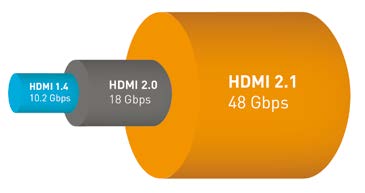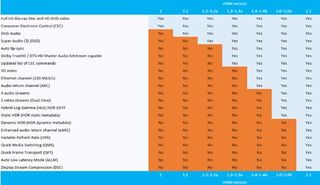Futuristic HDMI 2.1 Offers Near-Term Benefits

HDM1 2.1, a spec unleashed last month by the HDMI Forum, is aimed at improving video’s future, but some of the features and enhancements it enables might deliver near-term benefits to legacy set-tops, TVs and other audio/visual equipment.
Some elements of HDMI 2.1 will work with HDMI 2.0 equipment using a firmware upgrade rather than waiting for a new super-speedy HDMI cable and fresh silicon, according to Charles Cheevers, chief technology officer of Arris’s consumer premises equipment (CPE) business.
One example, he said, is the introduction of Dynamic HDR (High Dynamic Range), which can be supported using metadata and current silicon.
Rather than applying HDR to the entire video on a uniform basis, Dynamic HDR displays video at its “ideal values” in areas such as depth, brightness, contrast and wider color gamuts on a scene-by-scene or even a frame-by-frame basis.
“Even though it’s a 2.1 feature, it can be updated with a firmware change; it doesn’t break the hardware,” Cheevers said.
When those components would be implemented isn’t known yet, at least from the standpoint of Arris, which makes video infrastructure equipment, as well as set-top boxes and other broadband and video consumer premises equipment.
Cheevers said the next move will hinge on when studios and other content players plan to deliver Dynamic HDR video. Cable operators and other video service providers will also need to give guidance on when they’ll want those boxes to support Dynamic HDR.
Broadcasting & Cable Newsletter
The smarter way to stay on top of broadcasting and cable industry. Sign up below
Still, the bulk of the upgrades bundled into HDMI 2.1 are more future-facing.
Looking to keep up with demand, and perhaps over-provision, the demands of tomorrow’s television and video applications, the 2.1 specs will also support up to 48 Gbps of capacity and resolutions up to 10K. That will more than double the 18 Gbps supported by HDMI 2.0.

HDMI 2.1, available today to all 2.0 adopters, also supports faster refresh rates, including 8K60 and 4K120, as well as the aforementioned Dynamic HDR formats.
The HDMI Forum sees 10K coming into play for commercial AV, as well as industrial and other specialty use-cases. That’s notable because 4K TVs and content are just starting to get a grip on the market, and there has yet to be much firm commitment to support 8K. Is 10K a possibility? “That’s not even on the roadmap [yet],” Cheevers said.
The HDMI Forum also introduced an Ultra High Speed HDMI cable that can handle the higher data loads supported by HDMI 2.1, and “high bandwidth-depending features” such as uncompressed 8K video with HDR.
The group also noted that the new cable will be backward compatible with the installed base of HDMI devices.
Other features in 2.1 include Variable Refresh Rate (to eliminate lag, stutter and frame tearing for more fluid and detailed gameplay), Quick Media Switching for movies (eliminates the delay that can result in blank screens before content is displayed), and Quick Frame Transport, which reduces latency for smoother, no-lag gaming and real-time interactive VR.
The HDMI Forum will publish the 2.1 compliance test specs in stages during the first three quarters of 2018. It’s not predicting when HDMI 2.1-focused products will hit the market — it will be up to the manufacturers (and content suppliers) to set those timeframes.
Meanwhile, expect HDMI 2.1 to get some attention at next month’s CES show in Las Vegas. The HDMI Forum will provide more detail on new 2.1 specs and membership information at the show (LVCC South Hall I, booth 20542).
The HDMI Forum currently has 92 members. In addition to Arris, the group includes cable technology suppliers Broadcom, Dolby, Corning, Intel, Rohde & Schwarz, Samsung Electronics and Technicolor.










